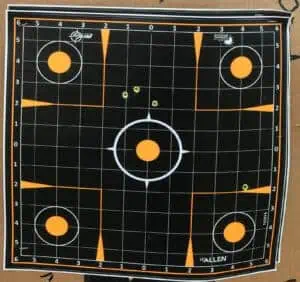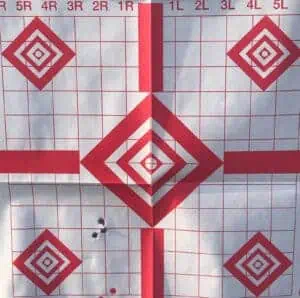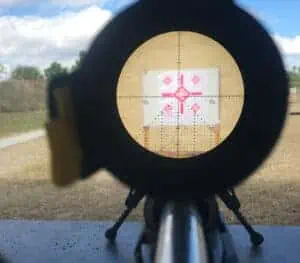What Is MOA, And Why Is It Useful?
Hang around gun owners, especially rifle owners, long enough and you’ll hear the term “MOA” (pronounced “EmOhAy”) tossed around repeatedly. MOA is a very flexible term. It can describe how accurate a gun is (“It’s a sub-MOA tack driver!”), the style of reticle in an optic, or how your rounds land on your target. However, many gun owners don’t know what MOA is really all about or how it applies to their ability to hit the target.
First off, let’s define the term. Anyone who’s picked up a protractor in grade school or measured angles on a jobsite knows that there are 360 degrees in a circle. However, each of those degrees can be broken down into smaller units of measurements for even more precise results. A degree can be split into 60 minutes when you need to define an angle more precisely. And yes, you guessed it, a minute of angle can be further broken down into 60 seconds of angle. We’re just concerned about minutes of angle, though, because those smaller measurements are rarely used on the range.
Here’s Your Angle On This
To recap, a minute of angle is a unit of angular measurement. Where a minute of angle becomes useful for shooters is how it interacts with the linear measurements of yards and inches.
For instance, at 100 yards, the gap between the two lines (or more specifically, rays) of one minute of angle is just over 1 inch across. Armed with this knowledge, we can now use the math behind the minute of angle along with the size of our target and the adjustment dials on our optics to adjust where our rounds land on target with great precision.
As we said before, one minute of angle is approximately one inch across at 100 yards. That gap scales up and down with the distance from the gun to the target. For instance, at 50 yards, the distance between the two rays in one MOA is just over ½ inch across. At 400 yards, that distance is a bit over 4 inches. Now all of sudden, we can look at the target, look at where we were aiming, and know exactly what adjustments we need to make in order to get on target.
The Target Is Speaking To You
 Take a look at the black target on the right. It is from a recent range session where I sighted in a new rifle. Each grid square on the target is one inch across. The group above the target was shot from a distance of 100 yards using a scope that has ¼ MOA adjustments. Knowing this, how many clicks, in what direction, will be needed to bring the shots on target?
Take a look at the black target on the right. It is from a recent range session where I sighted in a new rifle. Each grid square on the target is one inch across. The group above the target was shot from a distance of 100 yards using a scope that has ¼ MOA adjustments. Knowing this, how many clicks, in what direction, will be needed to bring the shots on target?
Going off the center of the three-shot group, I read it as 10 (or 11) clicks down, and 2 clicks to the right. (Remember, we move the crosshairs of an optic in the direction we want the bullets to land on the target).
What if that target was set at 200 yards, though? We know that every four clicks of our scope adjustment dial moves the bullet 1 MOA on the target, and that translates to one inch on the target at 100 yards. At 200 yards, though, four clicks of the dial (or 1 MOA) would move the rounds two inches on the target. Therefore, at 200 yards, 5 clicks down and 1 click to the right would be enough to get your rounds where they should be on the target. At 50 yards, the reverse is true. At that distance, 1 MOA is equal to ½ inch movement on the target, so all your clicks need to be doubled.
Scope It Out
 Minute of angle measurements can also be found inside a scope, especially those used in precision long-range rifle shooting. A reticle that has MOA markings on it can be used to quickly adjust where your rounds are landing on target, without adjusting your dials. If we look at the white target on the left, we can see that our group landed low and left on the target. Those squares are one inch across, so I know that if I were shooting at a distance of 100 yards, I’d have to adjust my aim point in my reticle by 3 MOA up and 2 MOA to the right. At 400 yards, though, both those movements would be less than one MOA. As most reticles don’t offer sub-MOA markings, I’d be better off adjusting my shots by using the dials on my scope rather than the markings on my reticle.
Minute of angle measurements can also be found inside a scope, especially those used in precision long-range rifle shooting. A reticle that has MOA markings on it can be used to quickly adjust where your rounds are landing on target, without adjusting your dials. If we look at the white target on the left, we can see that our group landed low and left on the target. Those squares are one inch across, so I know that if I were shooting at a distance of 100 yards, I’d have to adjust my aim point in my reticle by 3 MOA up and 2 MOA to the right. At 400 yards, though, both those movements would be less than one MOA. As most reticles don’t offer sub-MOA markings, I’d be better off adjusting my shots by using the dials on my scope rather than the markings on my reticle.
What is “Sub MOA,” and does it really matter?
Speaking of which, you may hear a rifle being described as a “sub-MOA gun.” This usually means it can shoot groups less than one inch at 100 yards (1 MOA is one inch at 100 yards, remember?). This is pretty extraordinary accuracy. A sub-MOA gun should do well for you in competition or when extreme precision is a priority.
The question is, though, are you a sub-MOA shooter? Can you make a precision rifle perform at its peak? The answer to this question for most gun owners, based on what I’ve seen at public ranges across the country, is “no.”
Guns are a reflection of the skill of the user. No amount of hardware will make up for bad marksmanship. Do you want better groups on paper and better hits at long range? Become a better shooter. Take an Appleseed class or a similar rifle marksmanship program. Spend time on the range analyzing what is working for you and your rifle, but more importantly, what isn’t working.
Make Math Work For You
Knowing what MOA is and making it work for you can radically affect your skill with a rifle. It can unlock some of the mysteries of rifle marksmanship and let you make shots you couldn’t make before. Learning the practical math of working the minutes of angle and how it translates onto your target at various distances will make you a better shooter and save you time and ammo on your next range trip.




